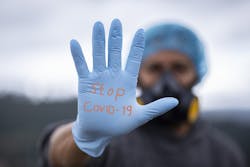A team of researchers at Beth Israel Deaconess Medical Center (BIDMC) has developed a mathematical means of assessing COVID-19 tests’ false-negative rate. The team’s methodology, which allows an apples-to-apples comparison of the various assays' clinical sensitivity, was published in the journal Clinical Infectious Diseases, according to a news release from the medical center.
"For getting back to business as usual, we all agree we've got to massively ramp up testing to figure out who's negative and who's infectious, but that's only going to work optimally if you can catch all the positive cases," said co-corresponding author James E. Kirby, MD, Director of the Clinical Microbiology Laboratories at BIDMC. "We found that clinical sensitivities vary widely, which has clear implications for patient care, epidemiology and the social and economic management of the ongoing pandemic."
COVID test results are usually reported as simply positive or negative. However, positive individuals can harbor radically different amounts of virus, or viral load, depending on how long they've been infected or how severe their symptoms are. In fact, viral load can vary as much as a hundred million-fold among individuals, said Kirby.
Using data from more than 27,000 tests for COVID-19 performed at Beth Israel Lahey Health hospital sites from March 26 to May 2, 2020, Kirby and colleagues first demonstrated that viral loads can be dependably reported.
Next, the researchers estimated the clinical sensitivity and the false-negative rate first for the in-house test, which was among the first to be implemented nationwide. Analyzing repeat test results for the nearly 5,000 patients who tested positive allowed the researchers to determine that the in-house test provided a false negative in about 10 percent of cases, giving the assay a clinical sensitivity of about 90 percent.
To estimate the accuracy of other assays, the team based their calculations on each test’s limit of detection, or LoD, defined as the smallest amount of viral DNA detectable that a test will catch 95 percent or more of the time.
The researchers demonstrated that the limit of detection can be used as a proxy to estimate a given assay's clinical sensitivity. By the team's calculations, an assay with a limit of detection of 1,000 copies viral DNA per mL is expected to detect just 75 percent of patients with COVID-19, providing one out of every four people with a false-negative. The team also showed that one test available today misses as many as one in three infected individuals, while another may miss up to 60 percent of positive cases.

